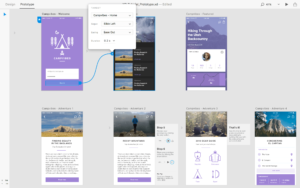Bob Regan is the Accessibility Product Manager at Macromedia, creators of a range of high profile Web development, graphics, and animation products including Dreamweaver, Flash and Director.
I spoke to him recently to see what’s happening at Macromedia with regards to accessibility.
Background
How did you first personally become involved in accessibility?
When I was a doctoral student at the University of Wisconsin, I was in charge of Web design instruction for faculty and staff. In late 1999, the university adopted a policy on Web accessibility. At that point, I not only had to learn about accessibility myself, I had to teach it to the faculty at the UW.
The more I got involved in the issue, the more I found it lined up with my interests as a teacher and as a researcher. Accessibility combines technology with issues of inclusion in ways that I found quite compelling. I soon changed my research field to align with the work I was doing in accessibility.
At the same time, I took a grounded approach to accessibility. Rather than teaching the technical aspects of the standards, I re-wrote the training materials we were using for Macromedia. Most of the faculty and staff I was working with were publishing or maintaining sites, but didn’t even know HTML. The technical requirements of the W3C guidelines were often very hard for faculty to understand. So I integrated the concept into the non-technical training we’d been delivering before. This made accessibility a much more ‘accessible’ topic for many of our faculty.
How long have you been involved with accessibility at Macromedia?
Almost two years. A representative from Macromedia came to visit the UW and heard about our work in accessibility. I was hired a few weeks after that.
When did Macromedia first start looking at the accessibility of its products?
One of the amazing things I learned about Macromedia when I first joined was how pervasive the thinking about accessibility was. The Dreamweaver team had been thinking about accessibility since Dreamweaver 3. The product manager at the time, a woman named Susan Morrow, wrote a manifesto of sorts that outlined the importance of accessibility from both social and economic perspectives.
Just after that, there was a group who was briefly left idle after an acquisition. To fill in the free time before development began on a new product there, the product manager asked them to build a plug-in for Dreamweaver that was similar to the accessibility validation tool known as Bobby. It was the first plug-in of its kind, and since then, every major validation company has authored a version of its own for authoring tools.
Then I met a number of folks who were working to advance the issue on their own, without any fanfare or discussion. The HomeSite product manager had attended a session on accessibility at the National Center for Accessible Media. From that point on, he decided that HomeSite should be an accessible product.
It was not until Section 508, the US Federal Requirement for government Websites, that Macromedia decided to hire someone to coordinate the issue. I was brought on board just before Section 508 was coming into effect.
Motivation
What is the driving force behind Macromedia’s work on improving Accessibility?
First and foremost, accessibility is the right thing to do. This is a company of individuals who are socially aware and active. Accessibility generates a unique kind of enthusiasm for technology and its potential to make our society a more open and equitable place.
At the same time, we couldn’t justify our work in accessibility without a strong business model. With the growing number of accessibility policies in the U.S., U.K. and around the world, we strive to make our tools the most accessible on the market. As people come to understand the importance of accessibility, we want them to think of Macromedia tools first.
As the Accessibility Product Manager for Macromedia, how do you see Macromedia’s relationship with the accessibility community as a whole?
Well, there is a difference between the accessibility and the disability communities. They overlap, but they are not synonymous. The accessibility community is a group of folks involved in accessibility standards, developing assistive technologies and ensuring that other technologies interoperate with assistive technologies and standards. These are folks like the W3C’s Web Accessibility Initiative, the Office of the e-Envoy in the UK, tool makers like GW Micro, and accessibility managers like myself at companies, universities and government offices.
The disability communities include groups like the Royal National Institute for the Blind, National Federation of the Blind and the Royal National Institute for the Deaf. These groups frequently have a deep involvement in the accessibility community, but they’re not the same thing.
There is no question that Macromedia would not be as successful as we have been in the area of accessibility without strong ties in the accessibility and disability communities. We invest a lot of our time in listening to our partners, and in helping to build examples of accessible content.
With which groups in the accessibility community do you have an active dialogue?
Macromedia has a strong relationship with the accessibility community through standards work in the W3C, and with local government and education. It’s important for us to stay involved in these efforts to build support for the standards directly into our tools, but also to ask questions within the working groups that help them understand how standards are built into products. I serve on the authoring tools accessibility guidelines working group within the W3C. I’m also in regular contact with my colleagues charged with enforcing standards in government departments in the US, the UK, Canada and Australia.
Within the disability communities, I have regular contact with groups like the National Federation of the Blind in the US, the RNIB in the UK, Vision Australia, Telecommunications for the Deaf, and the American Association of People with Disabilities. To address concerns of individuals with disabilities that are not organized into a large umbrella organization, I spend a lot of time with researchers back at the University of Wisconsin where I got my start.
Current Products – Output
How do you approach the improvement of the accessibility of your products’ outputs?
There are three measures that shape the output of our tools. First, we measure the output of our tools against Web and accessibility standards. Second, we check our tools for interoperability with assistive technologies such as screen readers. Third — and most importantly — we seek out input from customers with disabilities to collect feedback on our tools.
Which products are you focusing on primarily and how are you approaching this?
We try to incorporate accessibility into every product. However, we’re known for our work with Dreamweaver, Flash and Contribute.
What progress have you made so far?
Terrific, but we’re not done yet! Accessibility often involves a complicated process of building in support for accessibility APIs in the OS such as MSAA, assistive technologies and standards. In several instances, the industry has run into some very serious challenges.
We’re dedicated to continually making our tools better, more accessible and more usable for people with disabilities.
Are there any areas of accessibility where your products can produce output that’s more accessible than other technologies such as XHTML and CSS?
Accessibility needs to be understood broadly. For someone who’s blind, the most accessible form of content is plain text, perhaps marked up with xhtml and css. However, for someone with a cognitive disability, the least accessible form of content is plain text.
In order for many forms of content to be truly accessible, they need to be multi-modal. Think of a math course. Imagine trying to understand the concept of a diameter and the relationship to circumference without images. Using rich media technologies such as Flash, a teacher can present this concept interactively that may make the concept more accessible to many students with and without cognitive disabilities.
An interactive Flash movie may not be the most accessible format for a child who is blind, but that does not mean that it should not be available to child with other disabilities. It only means that it should not be the only means of accessing this content.
Current Products – Environment
How accessible are your product environments currently?
Both Dreamweaver and Contribute have been designed to be tools that can be easily used by people who are blind. We are working now with the National Federation of the Blind to develop tutorials for blind developers to learn html and Web design using our tools.
Will you be improving the accessibility of your product environments for disabled developers?
Yes. Whenever and wherever we can.
Developer Community
How are you improving the awareness of accessibility within your developer community?
We work to incorporate accessibility into all of our training and documentation materials, we include sessions on accessibility at our own conferences, and we deliver sessions at a variety of other conferences discussing accessibility.
What response have you had so far?
Very, very positive. Designers are increasingly required to incorporate accessibility into their specs. We are able to introduce the topic in a manner that’s both familiar to designers, and consistent with their existing workflow.
New Products
I believe you have a new product called Breeze coming out soon. What’s the take on accessibility there?
Breeze is currently the most accessible product of its kind on the market. We have worked to ensure that the solution is accessible to people with disabilities by adding in support for screen readers via the Flash player, but also via the keyboard, to make it easier to control the movie.
Does Macromedia Central affect the accessibility of Flash?
No, but the accessibility of Flash affects the accessibility of Central. At the moment, Central is not accessible, but like all our products, it is a priority.
Central is not accessible as it uses the standalone Flash player. At the moment, only the ActiveX Flash player is accessible.
Will accessibility be integrated into all new products?
Every product includes a plan for accessibility. We try to consider what use cases are likely for each product and incorporate support where we can. Obviously, the plan for Fireworks is different from the plan for Dreamweaver. However, there is a plan for every product.
Many thanks to Bob for taking the time to complete this interview.
Nigel is an experienced senior web developer with over twenty years experience. He is the website manager for Swift Plant Spares, a JCB parts supplier based in the UK. He can be found on LinkedIn.




